C2SM Newsletter vol. 26
Download newsletter as Downloadpdf (PDF, 933 KB)vertical_align_bottom.
Topics in this Newsletter - March 2018
- News from the Steering Committee
- News Global Modelling Activities
- News Regional Modelling Activities
- News Scientific Visualization Activities
- Visualization in Python Workshop
- Data Management Info Event
- Swiss Climate Change Scenarios CH2018
- IPCC activities around C2SM
- Note on climate science webcasts
- PhD defenses in the C2SM community
- Upcoming events of interest
- Paper: Cirrus Cloud Properties as Seen by the CALIPSO Satellite and ECHAM-HAM Global Climate Model
- Paper: Role of polar anticyclones and mid-latitude cyclones for Arctic summertime sea-ice melting
- Paper: Land radiative management as contributor to regional-scale climate adaptation and mitigation
- Paper: How Predictable Are the Arctic and North Atlantic Oscillations? Exploring the Variability and Predictability of the Northern Hemisphere
- Paper: Rossby Wave Propagation into the Northern Hemisphere Stratosphere: The Role of Zonal Phase Speed
- Paper: Strengthening seasonal marine CO2 variations due to increasing atmospheric CO2
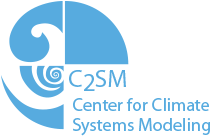
News from the Steering Committee
We regularly include information from the Steering Committee (SC) meetings and about decisions that have been taken.
Report from C2SM’s third SAB meeting
The Scientific Advisory Board (SAB) of C2SM met at ETH on 24 and 25 January 2018. The SAB, under the chairmanship of Bjorn Stevens (MPI-M) welcomed two new members, i.e., Karin Ammon (ProClim) and Jürg Füssler (INFRAS), replacing Christoph Ritz (retirement) and David Bresch (appointment at ETH), respectively. Albert Klein Tank (KNMI) and John Mitchell (Univ. Reading) who have been with the SAB since the beginning ensure the continuity of this board.
The SAB was first presented with an overview of C2SM's activities in the past three years. This included four presentations that highlighted recent scientific accomplishments, as well as statements by different C2SM members and stakeholders, including representatives of the ETH office of research and C2SM member Nina Buchmann in her role as head of the D-USYS department. The focus of the discussions was on the scientific and integrative role played by C2SM in the past, and the ways forward, particularly on the strategic directions C2SM wants to take in the future and how its contributions can be strengthened further in the coming years.
In the following, we summarize their recommendation letter:
C2SM has been very successful addressing the multi-faceted nature of the technological and communication challenges of weather and climate science in the ETH domain and beyond, which far exceed that which can be addressed by individual research groups. Since the last review C2SM has increasingly taken on the difficult role of developing a coherent climate and weather modelling strategy with MeteoSwiss and within the ETH domain. The effort has focused on ways to help maintain C2SM researchers at the forefront of the science, for instance through contributions to, and application of, the ICON model. The SAB notes several examples where this has advanced the research capabilities of ETH professors, as well as the operational capacity of MeteoSwiss, in ways that would be difficult to envision without C2SM. C2SM also continues to sharpen its profile as a communication platform, especially with respect to the activities surrounding the annual Klimarunde, and the Swiss national climate change scenarios. Through these activities C2SM has greatly raised the profile of ETH contributions to weather and climate science in both the public and private sphere.
To remain at the forefront of weather and climate science and to address emerging computational and technological challenges, ETH and the partners institutions need C2SM, now more than ever: C2SM establishes and strengthens links among its partners, provides a framework for identifying and collaborating on the development of common tools, and opens the door to integrated, unified and authoritative climate change data and knowledge not available for the non-ETH partners. In so doing it enables ETH to be recognized in this role, at a tiny fraction of the cost invested by other countries, and in ways that help ensure that climate change and climate-change impact research at ETH remains outstanding.
Next steps towards external evaluation
The SAB meeting served both as a measure to evaluate C2SM’s status quo and as a preparatory action for the external evaluation that ETH's executive board has asked us to undertake as a basis for them to decide whether and how to continue C2SM after its third phase ends in December 2020. As agreed upon at the SAB meeting, this external evaluation will take place in February or March 2019. The committee will consist of three to four external referees with one member of the SAB serving on the review committee as well.
The SC is now preparing this evaluation: In the first step undertaken until the summer, the SC and directorates of the partner institutions will determine the charges to the review committee and propose a list of the potential external reviewers to ETH's executive board. Once the committee is in place, handout documents such as an updated strategy and business plan and a compilation of the planned financial setup will be prepared and sent to this committee in autumn 2018.
Agroscope back on board
We are happy to announce that Agroscope, who inactivated its membership in 2017 due to the retirement of C2SM member Prof. Jürg Fuhrer, is now back on board as a full partner institution for the third phase of C2SM. Dr. Jens Leifeld who succeeded Jürg Fuhrer and is now head of the research group “Climate and agriculture” was voted to become a C2SM member at 2017’s plenary assembly. The contracts are currently being signed.
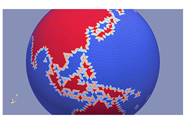
News Global Modelling Activities
Recent activities from the global climate modelling group mostly involved the ICON general circulation model. Practical expertise in working with the model was gained through participating in the ICON-HAMMOZ developer meeting in Leipzig. Moreover, to strengthen the links with the other international ICON developers, C2SM participated in the ICON developers meeting in Karlsruhe. In addition, C2SM organized two ICON meetings for its community members, one in January at Meteoswiss and one in March at ETHZ. The next C2SM-ICON meeting is planned to take place in June 2018. The C2SM-ICON meetings are announced via a mailing list. If you wish to subscribe, please send a short email to .
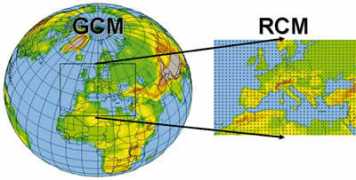
News Regional Modelling Activities
Recent code development activities from the regional climate modeling group have mostly involved improvements to the GPU version of the COSMO model. These include the incorporation of a new soil runoff parameterization into the GPU COSMO version, the calibration of the GPU version of COSMO for climate runs, and support for the porting of the GPU code into the official COSMO version. In addition to the development activities there were some outreach activities in the regional climate modeling group: The COSMO User Workshop, jointly organized by MeteoSwiss and C2SM, took place in January and had approximately 45 attendees. The program and presentations from the workshop can be found on the C2SM wiki. Additionally, in February, a Github information session was held at EMPA for new COSMO users.
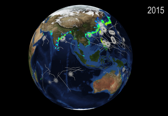
News Scientific Visualization Activities
Within scientific visualization, we have started to work on several interesting new projects:
- An animation aimed at presenting climate processes across global and regional scales. In this work we are using CESM simulation data for the global processes. For the regional processes we will use a COSMO 12 km simulation over the European domain and a COSMO 1 km simulation over the Swiss domain. The regional model simulation will be driven using the CESM data.
- Explanatory animations for the Swiss Climate Change Scenarios project CH2018.New animations of tropical cyclones and the damage caused by them.
- Sophisticated animations for the project "A future satellite constellation to quantify anthropogenic CO2 emissions". Some of the envisioned elements of this visualization include showing ECMWF global data, COSMO 1 km simulations over Berlin, multiple satellite swaths, and the detection of plumes as these satellites pass over Berlin.
- Further, we are also looking forward to creating visualizations for the Swiss Data Science Center project "Four-dimensional mapping of carbon dioxide using a low power sensor network". The details of this project will be decided later in this year.
As communicated previously, apart from working on longer directly paid projects, we continue to provide free-of-charge short duration (up to 2 days) visualization support to individual researchers. Therefore, if you have any questions or require support, feel free to contact .
For more information on our activities and recent animations, please visit our scientific visualization page.

Visualization in Python Workshop
C2SM, with support of Mathias Hauser from the Land-Climate Dynamics Group at the Institute for Atmospheric and Climate Science, held a two-day workshop on 7-8 February to introduce interested researchers of the C2SM community to visualization in the Python programming language. The workshop was very well received by the C2SM community with all the seats being reserved within a couple of days and several people on the waiting list. We received a very positive feedback from the attendees.
Based on the strong interest from the community we have decided to offer this workshop again on 19-20 June and on 4-5 September this year. For registrations of the June workshop, we gave preference to the non-ETH members of the C2SM community as most of the attendees in the February workshop were from ETH. This created another waiting list, which we used to fill the third workshop in September. There are a few places still available for the September course, you can register at the C2SM python visualization page.

Data Management Info Event
Proper data management is a key prerequisite for effective data sharing and publishing increasing the visibility of one’s scholarly work and likely increasing citation rates. Funding organisations like the external pageSwiss National Science Foundationcall_made or external pageHorizon 2020call_made mandate data management plans for projects they fund. The plans are already required at the proposal stage and should be updated throughout the project. In the field of weather and climate modelling, the massive amounts of data produced constitute a particular challenge in terms of data storage, reproducibility, and open accessibility.
On 5 March 2018, 29 C2SM community members attended C2SM’s first Data Management Info Event and Workshop, which we had organized in collaboration with ETH library and ETH Scientific IT Services (SIS). The event was split in two parts: in the morning, presentations on data management planning, active data management, publication of data, as well as data practices at the Institute for Atmospheric and Climate Science (IAC) and WSL provided comprehensive information on different aspects of data management from the time of their creation to publication also including valuable information on data management plans. In the afternoon, we discussed different core issues of data management in weather&climate science in different groups to come up with first ideas how to deal with these issues. In particular, we have established a C2SM task force on data management, which will regularly meet in the next half year with the aim to come up with recommendations for good data management practices in our field. The results from the task force will be presented at another event in the second half of 2018.
The presentations, as well as information on data management plans can be found at the C2SM wiki.
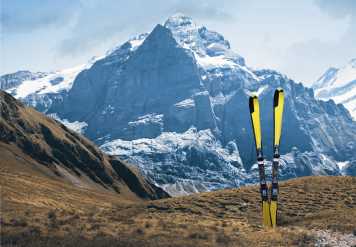
Swiss Climate Change Scenarios 2018
We are well into the year 2018, the namesake year of CH2018, and the project is nearing its completion. The Technical Report providing the scientific basis of the new Swiss climate scenarios has recently passed a review by 22 international experts and is in the stage of final revision. Our efforts now focus more on the dissemination of our results through a short brochure of the key findings, and an online presence of CH2018 resources as a flagship content of the National Center for Climate Services (NCCS), available at external pagewww.climate-scenarios.chcall_made. The new generation of Swiss climate scenarios will be published under the auspices of NCCS and ETH-Klimarunde on November 13 this year at ETH.
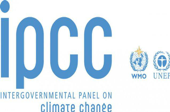
IPCC activities around C2SM
- Special Report on Global Warming of 1.5°C (SR15): The expert and government review of the second order draft of the Intergovernmental Panel on Climate Change (IPCC) Special Report on Global Warming of 1.5ºC has taken place from 8 January to 25 February 2018. This report is thus nearing its final stage, with its publication due in October 2018. SR15 is being prepared in response to an invitation from the 21st Conference of the Parties (COP21) to the United Nations Framework Convention on Climate Change in December 2015, as agreed under the Paris climate agreement. The report is being prepared under the joint scientific leadership of all three IPCC Working Groups, with support from the Working Group I Technical Support Unit. From Switzerland, C2SM member Sonia Seneviratne has been selected as lead author, and C2SM member Andreas Fischlin as review editor of this special report.
- Special Report on Climate Change and Land (SRCCL):
This report is a part of the IPCC Sixth Assessment Cycle and will be prepared jointly by the three Working Groups of the IPCC. The report will be finalized in September 2019 and will explore the interactions between climate change and desertification, land degradation, food security, sustainable land management, and opportunities and risks associated with land-based adaptation and mitigation responses to climate change. In October 2017, more than 100 experts from 52 countries met at the first Lead Author Meeting in Oslo to start planning the report. The authors have now produced an internal draft that has undergone an informal review. At the second Lead Author Meeting in New Zealand, they will address review comments and continue drafting the report. A First Order Draft will then be produced and will undergo a formal Expert Review process in the summer. Anyone with relevant expertise and experience will be able to sign-up to review the draft. From Switzerland, C2SM community member Edouard Davin (IAC) has been selected as Lead Author in the final chapter of this special report. - Special Report on the Ocean and Cryosphere in a Changing Climate (SROCC):
More than 120 researchers from around the world, including four from Switzerland (Thomas Frölicher, Univ. Bern; Nicolas Gruber, ETH Zürich (Chair C2SM), and Konrad Steffen, WSL (member C2SM) as lead authors and Andreas Fischlin (member C2SM) as vice-chair of IPCC), gathered in Quito, Ecuador, in February 2018 to advance their work on a report that will assess the state of research on the ocean, glaciers, polar ice caps and related topics. The work on this document is undertaken under the aegis of the Intergovernmental Panel on Climate Change (IPCC) and forms part of the 6th assessment cycle of IPCC. This report is a collaboration between all three working groups of IPCC, and thus will cover all fields from the physical basis of the changes all the way to the societal response to these changes, e.g., sea-level change. This was the second meeting of the lead authors and will result in the first order draft that will undergo an expert review in May and June of this year. See the IPCC SROCC web page for more information.

Note on climate science webcasts
Oliver Stebler, who was long part of Reto Knutti's Climate Physics Group at ETH and who created the well-known science webcasts "Werkstattgespräche", left ETH. His last webcast is the following:
- Vision “zero”. July 2100, weather reporter Knutti presents the forecast: “We see heavy precipitation in the Alpine valleys, some roads are still impassable. For the next week or two, a stable high pressure system will settle. This means we expect temperatures above 35 degrees Celsius.” Why could the weather forecast be different than today? ETH professor and C2SM member Reto Knutti explains the evidence and discusses a new vision for our society in his newest Workshop Interview. Watch it at Climate Science Visuals (in German).
The climate science webcasts (in German) will continue to be available at the Climate Physics Group's Werkstattgespräche page.

PhD Defenses in the C2SM Community
We congratulate our members for their successfully completed PhDs!
Jacopo Riboldi: Modulation of the downstream impact of extratropical transition by the midlatitude flow configuration: revisiting the phasing problem. ETH Zurich, 09 Feb 2018.
Elisa Lovecchio: Long range offshore transport of organic carbon from the Canary Upwelling System, an eddy-resolving modeling study. ETH Zürich, 19 Feb 2018.
Martin Frischknecht: New perspectives on the three-dimensional cycling of carbon and nutrients in the California Current System and its response to ENSO. ETH Zürich, 22 Feb 2018.
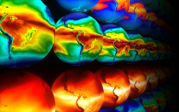
Upcoming Events of Interest
C2SM events 2018:
- 19/20 June: C2SM python visualization workshop, 1st repetition course. The course is booked out.
- 4/5 September 2018: 2nd repetition of C2SM python visualization workshop. There are still app. 5 places available.
- 10 July 2018: The 2nd GCM User Meeting is planned as a one-day get-together of GCM and Earth System modellers of the C2SM community.
- 16 July 2018: IAC Girls’ Experimental Day. Will be organized by C2SM in 2018.
- 13 November 2018: Launch of Swiss Climate Change Scenarios 2018, organized by NCCS, C2SM, and the CH2018 project.
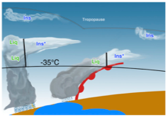
Paper: Cirrus Cloud Properties as Seen by the CALIPSO Satellite and ECHAM-HAM Global Climate Model
Cirrus clouds impact the planetary energy balance and upper-tropospheric water vapor transport and are therefore relevant for climate. In this study cirrus clouds at temperatures colder than -40°C simulated by the ECHAM-Hamburg Aerosol Module (ECHAM-HAM) general circulation model are compared to Cloud-Aerosol Lidar and Infrared Pathfinder Satellite Observations (CALIPSO) satellite data. The model captures the general cloud cover pattern and reproduces the observed median ice water content within a factor of 2, while extinction is overestimated by about a factor of 3 as revealed by temperature-dependent frequency histograms. Two distinct types of cirrus clouds are found: in situ-formed cirrus dominating at temperatures colder than -40°C and liquid-origin cirrus dominating at temperatures warmer than -55°C. The latter cirrus form in anvils of deep convective clouds or by glaciation of mixed-phase clouds, leading to high ice crystal number concentrations. They are associated with extinction coefficients and ice water content of up to 1 km-1 and 0.1 g m-3, respectively, while the in situ-formed cirrus are associated with smaller extinction coefficients and ice water content. In situ-formed cirrus are nucleated either heterogeneously or homogeneously. The simulated homogeneous ice crystals are similar to liquid-origin cirrus, which are associated with high ice crystal number concentrations. On the contrary, heterogeneously nucleated ice crystals appear in smaller number concentrations. However, ice crystal aggregation and depositional growth smooth the differences between several formation mechanisms, making the attribution to a specific ice nucleation mechanism challenging.
Gasparini, B., A. Meyer, D. Neubauer, S. Münch and U. Lohmann, Cirrus Cloud Properties as Seen by the CALIPSO Satellite and ECHAM-HAM Global Climate Model, J. Clim., 31, 1983-2003, doi: 10.1175/JCLI-D-16-0608.1, 2018.
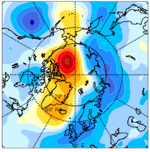
Paper: Role of polar anticyclones and mid-latitude cyclones for Arctic summertime sea-ice melting
Annual minima in Arctic sea ice extent and volume are decreasing rapidly since the late 1970ies, with substantial interannual variability. Summers with a particularly strong reduction of Arctic sea ice extent are characterized by anticyclonic circulation anomalies from the surface to the upper troposphere. This study shows that these seasonal circulation anomalies are the result of individual Arctic anticyclones (with a lifetime of typically 10 days). Sea ice reduction is systematically enhanced during Arctic anticyclones and the summertime reduction of sea ice volume correlates with the area averaged frequency of Arctic anticyclones poleward of 70°N (correlation coefficient of 0.57, see Figure). These anticyclones are formed via the injection of air masses with low potential vorticity from the extratropical storm track regions into the Arctic upper troposphere. These results emphasize the fundamental role of extratropical dynamics in establishing Arctic anticyclones and in turn seasonal circulation anomalies, which are of key importance for understanding the variability of summertime Arctic sea ice melting.
Wernli, H., and L. Papritz, 2018. Role of polar anticyclones and mid-latitude cyclones for Arctic summertime sea-ice melting. Nature Geosci., 11, 108–113.
Newspaper articles:

Paper: Land radiative management as contributor to regional-scale climate adaptation and mitigation
Greenhouse gas emissions urgently need to be reduced. Even with a step up in mitigation, the goal of limiting global temperature rise to well below 2°C remains challenging. Consequences of missing these goals are substantial, especially on regional scales. Because progress in the reduction of carbon dioxide emissions has been slow, climate engineering schemes are increasingly being discussed. But global schemes remain controversial and have important shortcomings. A reduction of global mean temperature through global-scale management of solar radiation could lead to strong regional disparities and affect rainfall patterns. On the other hand, active management of land radiative effects on a regional scale represents an alternative option of climate engineering that has been little discussed. Regional land radiative management could help to counteract warming, in particular hot extremes in densely populated and important agricultural regions. Regional land radiative management also raises some ethical issues, and its efficacy would be limited in time and space, depending on crop growing periods and constraints on agricultural management. But through its more regional focus and reliance on tested techniques, regional land radiative management avoids some of the main shortcomings associated with global radiation management. We argue that albedo-related climate benefits of land management should be considered more prominently when assessing regional-scale climate adaptation and mitigation as well as ecosystem services.
Seneviratne SI, Phipps SJ, Pitman AJ, Hirsch AL, Davin EL, Donat MG, Hirschi M, Lenton A, Wilhelm M, Kravitz B: Land radiative management as contributor to regional-scale climate adaptation and mitigation. Nature Geoscience, 29 January 2017, doi: external page10.1038/s41561-017-0057-5call_made
ETH News article, 29 Jan 2018 (DE)
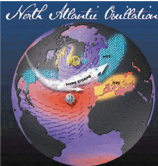
Paper: How Predictable Are the Arctic and North Atlantic Oscillations? Exploring the Variability and Predictability of the Northern Hemisphere
The North Atlantic Oscillation (NAO) and the Arctic Oscillation (AO) describe the dominant part of the variability in the Northern Hemisphere extratropical troposphere. Because of the strong connection of these patterns with surface climate, recent years have shown an increased interest and an increasing skill in forecasting them. However, it is unclear what the intrinsic limits of short-term predictability for the NAO and AO patterns are. This study compares the variability and predictability of both patterns, using a range of data and index computation methods for the daily NAO and AO indices. Small deviations from Gaussianity are found along with characteristic decorrelation time scales of around one week. In the analysis of the Lyapunov spectrum it is found that predictability is not significantly different between the AO and NAO or between reanalysis products. Differences exist, however, between the indices based on EOF analysis, which exhibit predictability time scales around 12–16 days, and the station-based indices, exhibiting a longer predictability of 18–20 days. Both of these time scales indicate predictability beyond that currently obtained in ensemble prediction models for short-term predictability. Additional longer-term predictability for these patterns may be gained through local feedbacks and remote forcing mechanisms for particular atmospheric conditions.
Domeisen, D., G. Badin, and I.M. Koszalka (2018), How Predictable Are the Arctic and North Atlantic Oscillations? Exploring the Variability and Predictability of the Northern Hemisphere, J. Clim., doi:10.1175/JCLI-D-17-0226.1
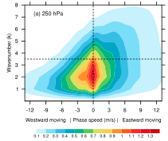
Paper: Rossby Wave Propagation into the Northern Hemisphere Stratosphere: The Role of Zonal Phase Speed
Sudden stratospheric warming (SSW) events are to a dominant part induced by upward propagating planetary waves. While theory predicts that the zonal phase speed of a tropospheric wave forcing affects wave propagation into the stratosphere, its relevance for SSW events has so far not been considered. This study shows in a linear wave diagnostic and in reanalysis data that phase speeds tend eastward as waves propagate upward, indicating that the stratosphere preselects eastward phase speeds for propagation, especially for zonal wave number 2. This also affects SSW events: Split SSW events tend to be preceded by anomalously eastward zonal phase speeds. Zonal phase speed may indeed explain part of the increased wave flux observed during the preconditioning of SSW events, as, for example, for the record 2009 SSW event.
Domeisen, D.I.V., O. Martius, and B.Jimene-Esteve (2018), Rossby Wave Propagation into the Northern Hemisphere Stratosphere: The Role of Zonal Phase Speed, Geophys. Res. Lett., doi:10.1002/2017GL076886.

Paper: Strengthening seasonal marine CO2 variations due to increasing atmospheric CO2
The amplitude of the seasonal cycle of CO2 in the world’s oceans is increasing. This has been verified by an international team of researchers, amongst them Nicolas Gruber, professor of environmental physics at the Institute of Biogeochemistry and Pollutant Dynamics (IBP) and chair of C2SM. This result is based on the to-date largest collection of surface ocean CO2 measurements analyzed in combination with a sophisticated data interpolation technique. The team was able to demonstrate that the added CO2 has led to an increase in the seasonal amplitude of CO2 that in agreement with independent measurements from timeseries stations and basic thermodynamic considerations. While the study highlights the advances of the surface ocean observing networks for CO2 and our ability to validate model predictions, the study also emphasizes the detectable imprint human emissions have already left on the global oceans. In other words, these fluctuations can be viewed as a gigantic human footprint in the sea, which could have severe consequences for marine life owing to its aggravating impact of ocean acidification.
Landschützer, P. N. Gruber, D.C.E. Bakker, I. Stemmler, and K.D. Six (2018), Strengthening seasonal marine CO2 variations due to increasing atmospheric CO2, Nature Climate Change, doi:10.1038/s41558-017-0057-x
D-USYS News: “Human footprint on world’s oceans, 29 Jan 2018 (EN)
